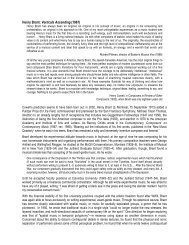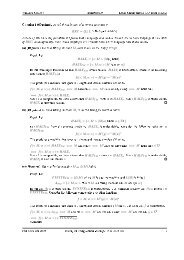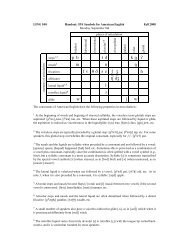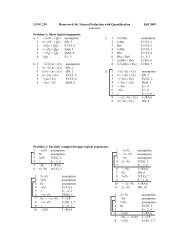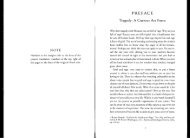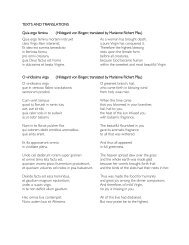Chapter 4 Evening in Germany: - Williams Students Online
Chapter 4 Evening in Germany: - Williams Students Online
Chapter 4 Evening in Germany: - Williams Students Online
You also want an ePaper? Increase the reach of your titles
YUMPU automatically turns print PDFs into web optimized ePapers that Google loves.
<strong>Chapter</strong> 4<br />
<strong>Even<strong>in</strong>g</strong> <strong>in</strong> <strong>Germany</strong>:<br />
National Socialism and the Myth of Langemarck<br />
The film version of Erich Maria Remarque’s All Quiet on the Western Front had its German<br />
première <strong>in</strong> Berl<strong>in</strong> on December 4, 1930. The German version had been modified slightly from the<br />
American orig<strong>in</strong>al, remov<strong>in</strong>g some material that might have been seen as anti-German. It passed the<br />
censors without objection. The première was quite successful; the Vossische Zeitung wrote approv<strong>in</strong>gly,<br />
“The frightful irrationality of war emerges most clearly <strong>in</strong> the film’s big battle scenes… [the] most<br />
mov<strong>in</strong>g which we have experienced <strong>in</strong> sound-film so far.” 1<br />
Elsewhere <strong>in</strong> Berl<strong>in</strong>, the Nazi parliamentary<br />
faction had been gathered s<strong>in</strong>ce December 3. Joseph Goebbels, then Gauleiter [regional party leader] of<br />
Berl<strong>in</strong>, perceived that the show<strong>in</strong>g of the film was an “opportunity [for him] to show off <strong>in</strong> front of the<br />
party bosses.” 2<br />
On December 5, he and roughly 200 other SA men and Nazi MPs attended the screen<strong>in</strong>g<br />
of the movie <strong>in</strong> the Mozartsaal c<strong>in</strong>ema. They scattered themselves throughout the c<strong>in</strong>ema; about ten<br />
m<strong>in</strong>utes <strong>in</strong>to the film, the darkened theater fell <strong>in</strong>to chaos. The Nazis threw smoke-bombs and paper<br />
bags filled with sneez<strong>in</strong>g powder from the balcony <strong>in</strong>to the audience. They released white mice <strong>in</strong> the<br />
stalls. They shouted th<strong>in</strong>gs like “filthy film,” “pigsty,” and “throw the Jews out.” 3 The film was stopped;<br />
Goebbels declared that “Hitler is <strong>in</strong> the front of the gates of Berl<strong>in</strong>.” The police were called <strong>in</strong> to clear<br />
out the c<strong>in</strong>ema. Goebbels, writ<strong>in</strong>g <strong>in</strong> his diary, reflected on the demonstration:<br />
The c<strong>in</strong>ema has been turned <strong>in</strong>to a madhouse a mere ten m<strong>in</strong>utes after the start of the film….<br />
The Jews try to make themselves <strong>in</strong>visible…. Afterwards I sit <strong>in</strong> a café with my lads;<br />
experiences are swapped; it is hilariously funny, but everyth<strong>in</strong>g has worked well.... Once aga<strong>in</strong> I<br />
have had the right scent. 4<br />
For the next few nights, the manager of the c<strong>in</strong>ema was able to keep the Nazis at bay with the<br />
help of police protection; a demonstration of 8,000 people on December 9 prompted the head of police to<br />
1 Quoted <strong>in</strong> Mart<strong>in</strong> Broszat, Hitler and the Collapse of Weimar <strong>Germany</strong> (New York: Berg, 1987), 32.<br />
2 Ibid., 33.<br />
3 Ibid.<br />
1
prohibit all demonstrations <strong>in</strong> Berl<strong>in</strong>. By this time, though, the scandal had grown so large that the film<br />
board decided to withdraw their support, bann<strong>in</strong>g the film with the claim that the controversy was<br />
endanger<strong>in</strong>g <strong>Germany</strong>’s reputation abroad. 5 Der Angriff justified the protests by referr<strong>in</strong>g to the memory<br />
of the dead soldiers. “Yesterday even<strong>in</strong>g <strong>in</strong> the vic<strong>in</strong>ity of the Nollendorfplatz and the Wittenbergplatz<br />
30,000 to 40,000 Germans protested aga<strong>in</strong>st the <strong>in</strong>sult<strong>in</strong>g and sully<strong>in</strong>g of the German front soldiers, <strong>in</strong><br />
particular the heroic youth of Langemarck.” 6<br />
As this story suggests, memory of the War was at the center of the cultural and political life of<br />
the Weimar Republic. Just as <strong>in</strong> Brita<strong>in</strong>, the issues raised by the war books and films were as important<br />
as they were controversial. Allegiance to the legacy of the War, especially the legacy of Langemarck,<br />
was a crucial part of the public image that the National Socialists wished to project. Compar<strong>in</strong>g the<br />
soldiers of the War to the Nazis who died <strong>in</strong> the failed putsch of 1923, the author Fritz F<strong>in</strong>k wrote that<br />
“the yearn<strong>in</strong>g for the Reich that flared up at Langemarck found its fulfillment at the Feldherrnhalle.” 7<br />
Before exam<strong>in</strong><strong>in</strong>g the Nazi appropriation of the myth of Langemarck, though, it is necessary to consider<br />
the peculiar nature of Nazi ideology.<br />
Nazi Ideology and the Weakness of the Weimar Republic<br />
To exam<strong>in</strong>e Nazi ideology is to delve <strong>in</strong>to controversy, for the ideological bases of the<br />
movement are still widely debated. It is important to make three po<strong>in</strong>ts to clarify the discussion. First,<br />
despite the claims that many have made that Nazism was fundamentally opportunistic, it did have an<br />
ideology. Though not always coherent, nor terribly consistent, the Nazi movement was based on a core<br />
4 Quoted <strong>in</strong> Broszat, 34.<br />
5 Ibid., 35.<br />
6 Der Angriff, December 9, 1930 (Gestern abend protestierten im Umkreis des Nollendorfplatzes und<br />
Wittenbergplatzes 30.000 bis 40.000 deutsche Menschen gegen die Beschimpfung und Besudelung der<br />
deutschen Frontkämpfer, <strong>in</strong>sbesondere der heldenhaften Jugend von Langemarck.).<br />
7 Quoted <strong>in</strong> Uwe- K. Ketelsen, “»Die Jugend von Langemarck« E<strong>in</strong> poetisch-politisches Motiv der<br />
Zwischenkriegszeit,” <strong>in</strong> Thomas Koebner, Rolf-Peter Janz, and Frank Trommler, eds., »Mit uns zieht die neue<br />
Zeit« Der Mythos Jugend (Frankfurt am Ma<strong>in</strong>: Suhrkamp Verlag, 1985), 79 (Die Sehnsucht nach dem Reich,<br />
die <strong>in</strong> Langemarck aufgelodert war, fand ihre Erfüllung an der Feldherrnhalle.).<br />
2
set of beliefs. The pragmatic element certa<strong>in</strong>ly was present, but it was not the only, or the prime,<br />
motivat<strong>in</strong>g force. Second, National Socialism, for all the features it shared <strong>in</strong> common with other<br />
European fascist movements, especially the Italian one, was uniquely German. It depended on certa<strong>in</strong><br />
beliefs about culture, civilization, and history that had developed primarily <strong>in</strong> <strong>Germany</strong>. F<strong>in</strong>ally, the Nazi<br />
movement was essentially a war movement. It had its genesis <strong>in</strong> the war of 1914-1918 and its end <strong>in</strong> the<br />
war of 1939-1945 and preached war <strong>in</strong> between. For this reason, the myth of Langemarck, which was a<br />
war myth, was very important to Nazism as a whole.<br />
The elements that comprised the myth of Langemarck—youth, nation, and sacrifice—may<br />
<strong>in</strong>itially seem at odds with the Nazi emphasis on mach<strong>in</strong>es, technology, and “new men.” Langemarck<br />
was essentially a backward-look<strong>in</strong>g product of Romanticism; by contrast, many elements of Nazism were<br />
oriented toward the future, follow<strong>in</strong>g on the heels of the futurist F. T. Mar<strong>in</strong>etti, who wrote, “Why should<br />
we look back, when was we want is to break down the mysterious doors of the Impossible? Time and<br />
Space died yesterday. We already live <strong>in</strong> the absolute, because we have created eternal, omnipresent<br />
speed.” 8 Bernd Hüppauf, <strong>in</strong> his excellent article, “The Birth of Fascist Man from the Spirit of the Front,”<br />
deals with the contradiction easily; the myth of Langemarck, he says, was used cynically by the Nazis<br />
because of its mass appeal; it was little more than “a smoke-screen.” 9 In his account, the really important<br />
myth for the Nazis was not that of Langemarck, but that of Verdun, a myth “of the emotionless and<br />
hardened modern warrior who functioned like a mach<strong>in</strong>e.” 10<br />
However, it is not necessary to dismiss the<br />
importance of Langemarck to the Nazis so quickly. As was argued <strong>in</strong> chapter 2, the apparent apolitical<br />
idealism of Langemarck was only an illusion, for the myth could be read <strong>in</strong> a number of more aggressive<br />
ways. Its close connection to the youth movement, especially, left the myth of Langemarck strongly<br />
opposed to Weimar democracy. Further, Nazism itself was not solely a worship of mach<strong>in</strong>es and<br />
technology. One of its most important characteristics, <strong>in</strong> fact, was its embrace the paradoxical opposites<br />
8 Filippo Tommaso Mar<strong>in</strong>etti, “The Futurist Manifesto,” <strong>in</strong> Adrian Lyttelton, ed., Italian Fascisms: From<br />
Pareto to Gentile (London: Cape, 1973), 212.<br />
9 Bernd Hüppauf, “The Birth of Fascist Man from the Spirit of the Front: From Langemarck to Verdun,” <strong>in</strong> John<br />
Milfull, ed., The Attractions of Fascism (New York: Berg, 1990), 56.<br />
3
of past and future, a comb<strong>in</strong>ation Jeffrey Herf calls “reactionary modernism.” 11<br />
Modris Ekste<strong>in</strong>s, <strong>in</strong><br />
discuss<strong>in</strong>g the idea of the fusion of past and future, suggests that Nazism wished to use the past or the<br />
myth of the past to pursue the future, phras<strong>in</strong>g it this way:<br />
The implication of [one description] is that Nazism used the tools and technology of modernity<br />
<strong>in</strong> an attempt to impose on <strong>Germany</strong> a vision of the past. As we have argued, that would be to<br />
mis<strong>in</strong>terpret, <strong>in</strong> fact to reverse, the central thrust of the movement <strong>in</strong> the context of its age. 12<br />
The view of the idealized past the Nazis were able to project through the language of Langemarck<br />
enabled them to pursue their modernist designs. These two elements, past and future, technology and<br />
myth, were not entirely separate as Hüppauf suggests, but rather, amid the confusions of fascist ideology,<br />
one and the same.<br />
Hitler, as the Nazi propagandists never tired of mention<strong>in</strong>g, was a veteran of the War. In Me<strong>in</strong><br />
Kampf, he recounted his experience at Langemarck:<br />
We marched silently through a wet, cold night <strong>in</strong> Flanders, and just as the sun began to disperse<br />
the fog, an iron greet<strong>in</strong>g was sent our way and shrapnel and shells exploded all around us; but<br />
before the smoke had cleared, the first hurrahs welled up from two hundred voices as the first<br />
messengers of death. Then we heard the crack and roar of gunfire, s<strong>in</strong>g<strong>in</strong>g and yell<strong>in</strong>g, and<br />
with wild eyes we all lunged forward, faster and faster, until suddenly man-to-man fight<strong>in</strong>g<br />
broke out <strong>in</strong> turnip fields and thickets. We heard the sounds of a song from afar which came<br />
closer and closer to us, pass<strong>in</strong>g from one company to another, and then, just as men were dy<strong>in</strong>g<br />
all around us it spread <strong>in</strong>to our ranks, and we passed it on: “Deutschland, Deutschland über<br />
alles, über alles <strong>in</strong> der Welt!” 13<br />
It was an <strong>in</strong>troduction of youth to adulthood: “seventeen-year-old boys,” he said, “now looked like<br />
men.” 14 The theme of youth was comb<strong>in</strong>ed with those of death and maturity, or, rather, a rejuvenation of<br />
manhood by youthful vigor. Hitler’s political vision was a translation of this experience of war <strong>in</strong>to a<br />
sweep<strong>in</strong>g program for society. “Only by understand<strong>in</strong>g the Fronterlebnis [experience of the front],” said<br />
10 Ibid., 61.<br />
11 Jeffrey Herf, Reactionary Modernism: Technology, Culture, and Politics <strong>in</strong> Weimar and the Third Reich<br />
(New York: Cambridge University Press, 1984).<br />
12 Modris Ekste<strong>in</strong>s, Rites of Spr<strong>in</strong>g: The Great War and the Birth of the Modern Age (New York: Doubleday,<br />
1989), 328.<br />
13 Quoted <strong>in</strong> Jay W. Baird, To Die For <strong>Germany</strong>: Heroes <strong>in</strong> the Nazi Pantheon (Bloom<strong>in</strong>gton: Indiana<br />
University Press, 1990), 4.<br />
14 George L. Mosse, Fallen Soldiers: Reshap<strong>in</strong>g the Memory of the World Wars (New York: Oxford University<br />
Press), 72.<br />
4
one supporter, “can one understand National Socialism.” 15<br />
Hitler believed that a modern future was<br />
made possible by look<strong>in</strong>g back to the War and, further, back to a mythical German past; Langemarck<br />
comb<strong>in</strong>ed these two elements perfectly.<br />
The role of the Langemarck myth <strong>in</strong> Nazi ideology is especially important because of the crucial<br />
role of a publicly presented ideology <strong>in</strong> the rise of the Nazis and the correspond<strong>in</strong>g fall of Weimar. The<br />
Weimar political system was troubled from birth. It was born under an <strong>in</strong>auspicious cloud of defeat <strong>in</strong><br />
the War. The Republic did not spr<strong>in</strong>g from a long-stand<strong>in</strong>g tradition of representative democracy; it<br />
was <strong>in</strong> some ways a “makeshift democracy,” produced by the loss of the War. 16<br />
One of its first<br />
significant actions was to accept the Treaty of Versailles, a treaty that not only imposed harsh<br />
reparations but also explicitly assigned responsibility for the War to the Germans. Many Germans,<br />
believ<strong>in</strong>g the overoptimistic propaganda that was was produced by the High Command until the end,<br />
were genu<strong>in</strong>ely surprised by the conclusion of the War. They felt, wrongly, that the German troops<br />
had not been defeated <strong>in</strong> the field, a belief supported by the German military. The frustration with the<br />
sudden, unfavorable conclusion to the War was therefore not attached to the military that lost the War<br />
but rather the government that accepted the consequences of the loss. In 1919, General Paul von<br />
H<strong>in</strong>denburg presented the official military version of the end of the War:<br />
An English general said with justice: “The German army was stabbed <strong>in</strong> the back.” No guilt<br />
applies to the good core of the army.... Where the guilt lies has clearly been demonstrated. If it<br />
needed more proof, then it would be found <strong>in</strong> the quoted statement of the English general and <strong>in</strong><br />
the boundless astonishment of our enemies at their victory. 17<br />
The civilians were blamed for the military defeat; they, said H<strong>in</strong>denburg, had lost their “will to victory.” 18<br />
Further, the civilian government was not <strong>in</strong> a strong position to combat this pernicious myth; it could not<br />
afford to attack the suffer<strong>in</strong>g or courage of the soldiers of the War. Friedrich Ebert, chancellor and leader<br />
15 Quoted <strong>in</strong> Ekste<strong>in</strong>s, 307.<br />
16 Eberhard Kolb, The Weimar Republic (London: Unw<strong>in</strong> Hyman, 1988), 3.<br />
17 Paul von H<strong>in</strong>denburg, “The Stab <strong>in</strong> the Back,” <strong>in</strong> Anton Kaes, Mart<strong>in</strong> Jay, and Edward Dimendberg, eds., The<br />
Weimar Republic Sourcebook (Berkeley: University of California Press, 1994), 16.<br />
18 Ibid., 15.<br />
5
of the Social Democrats, welcomed the soldiers return<strong>in</strong>g to Berl<strong>in</strong> <strong>in</strong> December 1918 by claim<strong>in</strong>g that<br />
they were return<strong>in</strong>g undefeated. 19<br />
German propaganda, <strong>in</strong> l<strong>in</strong>e with the stab-<strong>in</strong>-the-back myth, asserted that return<strong>in</strong>g soldiers were<br />
generally dishonored by the civilians: their sacrifices forgotten, they were left to unemployment and<br />
poverty. The image of soldiers hav<strong>in</strong>g their <strong>in</strong>signia torn from their uniforms as they arrived home was a<br />
common one. However, as Richard Bessel has argued, this was not really the case at all. German<br />
soldiers were fairly successfully re<strong>in</strong>tegrated <strong>in</strong>to German society. In this case, though, the myth was as<br />
important as reality, and the myth represented the soldiers as betrayed and subsequently dishonored by<br />
the civilians. Amid the period of stabilization and re<strong>in</strong>tegration, therefore, there was also a burgeon<strong>in</strong>g<br />
myth of a government betray<strong>in</strong>g the German spirit embodied <strong>in</strong> its soldiers.<br />
For this reason, even as the Weimar Republic weathered the crises of its early years and began to<br />
show signs of succeed<strong>in</strong>g, there was an undercurrent of deep bitterness directed aga<strong>in</strong>st the government<br />
and aga<strong>in</strong>st the civilians. This tendency, never fully repressed by a weak government, was to return <strong>in</strong><br />
strength when the Republic began to face the economic probems that were to lead to its downfall. One<br />
member of the Freikorps expressed it by say<strong>in</strong>g, “People told us that the War was over. That made us<br />
laugh. We ourselves are the War.” 20<br />
The War formed part of the identities of many people, and evoked<br />
correspond<strong>in</strong>gly strong emotions. The myth of Langemarck, as one of the most common stories about<br />
the War, was centrally important for an <strong>in</strong>terwar <strong>Germany</strong> struggl<strong>in</strong>g with its past.<br />
In conjunction with the problems result<strong>in</strong>g from the loss of the War, Weimar democracy faced a<br />
number of structural problems. The system of proportional representation established by the Constitution<br />
was on the cutt<strong>in</strong>g edge at the time, considered the most fair system of elect<strong>in</strong>g governments. It meant,<br />
however, that spl<strong>in</strong>ter groups of the extreme left and right would not be shut out of the government by<br />
their <strong>in</strong>ability to w<strong>in</strong> majorities. This, comb<strong>in</strong>ed with the parties largely left <strong>in</strong>tact from the imperial<br />
19 Richard Bessel, “The Great War <strong>in</strong> German Memory: The Soldiers of the First World War, Demobilization,<br />
and Weimar Political Culture,” German History 6 (April 1988), 21.<br />
20 Quoted <strong>in</strong> Barbara Ehrenreich, foreword to Klaus Theweleit, Male Fantasies, vol. 1 (M<strong>in</strong>neapolis: University<br />
of M<strong>in</strong>nesota Press, 1987), x.<br />
6
days, produced a fragmented political system. The parties represented class and economic <strong>in</strong>terests, not<br />
philosophical or ideological positions. The <strong>in</strong>itial agreements between the employers and the trade<br />
unions made possible a coalition government which encompassed both left and right. When, however, <strong>in</strong><br />
the depressed economic circumstances of the late 1920s this coalition fell apart, majority rule became<br />
impossible. The authoritarian solution, first practiced by Chancellor He<strong>in</strong>rich Brün<strong>in</strong>g as allowed by the<br />
Constitution, signaled the end of the viable democracy <strong>in</strong> Weimar.<br />
At the same time, the extreme political fragmentation produced frustration with<strong>in</strong> the voters.<br />
With the focus on narrow <strong>in</strong>terest groups, the only possible mass party would be one which could cut<br />
across these <strong>in</strong>terest groups with an ideology with mass appeal. The nature of the middle class <strong>in</strong><br />
<strong>Germany</strong>, further, meant that such a group could only form on the political right; the left, especially the<br />
KPD, cont<strong>in</strong>ued to grow, but could not hope for a majority. In these conditions, the National Socialists<br />
were thrust forward dur<strong>in</strong>g the campaign aga<strong>in</strong>st the Young Plan <strong>in</strong> 1929. Their first widespread public<br />
appearance, aided by the deep pockets of the <strong>in</strong>dustrialist Alfred Hugenberg, was <strong>in</strong> a campaign aga<strong>in</strong>st<br />
the Republic’s acceptance of the conditions of Versailles. The Young Plan was economically helpful for<br />
<strong>Germany</strong>, but the Nazis ga<strong>in</strong>ed status by stand<strong>in</strong>g apart from the negotiations that took the German defeat<br />
<strong>in</strong> the War as its fundamental basis. The Nazis offered a foundation <strong>in</strong> ideology rather than <strong>in</strong> economic<br />
<strong>in</strong>terest; moreover, they were headed by a charismatic leader. Their ideology, comb<strong>in</strong><strong>in</strong>g a Romantic<br />
praise of the past and of youth with a modernist vitality and energy which contrasted well with the<br />
perceived lifelessness of Weimar, was quite attractive to many Germans.<br />
In short, the Nazis appeared <strong>in</strong> favorable circumstances preach<strong>in</strong>g an ideology tailored to suit<br />
those who were dissatisfied with the Republic. Although they never atta<strong>in</strong>ed a majority, the National<br />
Socialists became the largest party <strong>in</strong> the Reichstag; eventually the government tried to accommodate<br />
them, little realiz<strong>in</strong>g that they could not be accommodated. He<strong>in</strong>rich Mann traced the attraction of Hitler<br />
to the <strong>in</strong>ner condition of the German people: “they have not overcome the war; it cont<strong>in</strong>ues to rule them<br />
7
and, <strong>in</strong> their feel<strong>in</strong>gs, has never ended.” 21 Hitler’s opportunity, he said, came because of the mentality of<br />
the Germans: eternally besieged, they looked to the one who offered them an ideology and a way out of<br />
their condition. Like the crowds at Hitler’s nighttime rallies, rallies held late <strong>in</strong> the even<strong>in</strong>g <strong>in</strong> order to<br />
catch the audience tired and ready to submit, the nation of <strong>Germany</strong> was worn down by its struggle and<br />
was consequently susceptible to the appeal of Nazism: “It is already even<strong>in</strong>g <strong>in</strong> <strong>Germany</strong>,” he wrote, “if<br />
not midnight.” 22<br />
The Legacy of Langemarck: Use and Politicization<br />
The myth of Langemarck was at the center of the War’s cont<strong>in</strong>ued <strong>in</strong>fluence. A 1934 headl<strong>in</strong>e<br />
<strong>in</strong> the Völkischer Beobachter, a Nazi paper, proclaimed proudly, “The Spirit of Langemarck Lives!” 23 In<br />
the words of another writer, “this word [Langemarck] has become a liv<strong>in</strong>g force” to keep alive the past. 24<br />
The adoption of the myth of Langemarck by the Nazis was gradual, as the myth was slowly rewritten to<br />
emphasize its aggressive connotations and to ignore the apolitical ones. Part of the significance of the<br />
myth of Langemarck arose from the lack of competition; it appeared <strong>in</strong> someth<strong>in</strong>g of a mythical vacuum.<br />
At the Nuremberg rally of 1935, Hitler said that history values no nation except those that build their own<br />
monuments. 25<br />
By this standard, the Weimar Republic was particularly unsuccessful. It could not settle<br />
on an accepted day of national celebration. Some parties supported a day of celebration on the<br />
anniversary of the found<strong>in</strong>g of the Reich <strong>in</strong> 1871 and some supported a commemoration of the found<strong>in</strong>g<br />
of the Republic <strong>in</strong> 1919; noth<strong>in</strong>g was resolved. Likewise, no Day of Mourn<strong>in</strong>g for the War was<br />
universally accepted; there were a number of compet<strong>in</strong>g ideas (<strong>in</strong>clud<strong>in</strong>g a national celebration of the<br />
21 He<strong>in</strong>rich Mann, “The German Decision,” <strong>in</strong> Kaes, Jay, and Dimendberg, 165.<br />
22 Ibid., 164.<br />
23 Völkischer Beobachter, November 13, 1934, 2.<br />
24 Karl August Walther, ed., Das Langemarckbuch der Deutschen Studentenschaft (Leipzig: Verlag von K.F.<br />
Koehler, 1933), 11 (Dieses Wort is e<strong>in</strong>e lebendige Kraft geworden).<br />
25 George Mosse, The Nationalization of the Masses (New York: Howard Fertig, 1975), 183.<br />
8
Day of Langemarck supported by students’ and veterans’ organizations). 26<br />
In the same way, the<br />
Republic was unsuccessful <strong>in</strong> construct<strong>in</strong>g conv<strong>in</strong>c<strong>in</strong>g memorials. A shr<strong>in</strong>e <strong>in</strong> honor of the tenth<br />
anniversary of the outbreak of the War was proposed <strong>in</strong> 1924, but it never came to fruition; the process<br />
was paralyzed by the compet<strong>in</strong>g offer<strong>in</strong>gs and ideas proposed by various organizations and cities. The<br />
few memorials it did build were departures from traditional German memorial iconography. One<br />
memorial to honor the dead of the War was a hall that conta<strong>in</strong>ed a library and a read<strong>in</strong>g room; another<br />
was a huge crystal ball. The library drew on rational and <strong>in</strong>tellectual ideals; the crystal ball was more<br />
modernist <strong>in</strong> its references. Neither was successful. Such efforts, suggests George Mosse,<br />
were considered by some as a negation of patriotic and warlike themes. National monuments<br />
cont<strong>in</strong>ued to be viewed as sacred places, as secular, national shr<strong>in</strong>es, frameworks for acts of<br />
national worship. Neither read<strong>in</strong>g rooms nor crystal balls could fulfill this function. 27<br />
This poverty of memorial expression that marked the Republic led to many perceiv<strong>in</strong>g it as “cold,<br />
rationalistic and dull.” 28 The Republic’s failure to produce significant memorials was symptomatic of its<br />
<strong>in</strong>ability to <strong>in</strong>spire loyalty. Even <strong>in</strong> its best years, many of those support<strong>in</strong>g it did so with little emotional<br />
enthusiasm.<br />
It is <strong>in</strong> this context that the return of the dead <strong>in</strong> the myth of Langemarck is to be understood. By<br />
its very nature traditional and spiritual, Langemarck was <strong>in</strong> opposition to the perceived rationalism of the<br />
Weimar Republic. Because of the political situation, it was nearly impossible for the emotions associated<br />
with Langemarck to be mobilized <strong>in</strong> favor of the Republic. Langemarck, mobiliz<strong>in</strong>g the vocabulary of<br />
the distant Germanic past, stood for everyth<strong>in</strong>g the Republic was perceived as stand<strong>in</strong>g aga<strong>in</strong>st. If the<br />
War was remembered primarily <strong>in</strong> terms of Langemarck, <strong>in</strong> terms of the sacrifice of youth betrayed by a<br />
civilian denial of the German spirit, then it would only be to the detriment of the Republic. The political<br />
struggle of the 1920s and 1930s was a struggle about the legacy of the War; this legacy was determ<strong>in</strong>ed,<br />
26 Bernd Hüppauf, “The Birth of Fascist Man from the Spirit of the Front: From Langemarck to Verdun,” <strong>in</strong><br />
John Milfull, ed., The Attractions of Fascism (New York: Berg, 1990), 54.<br />
27 Mosse, Nationalization, 71.<br />
28 Hüppauf, 54.<br />
9
<strong>in</strong> part, by the vocabulary used to represent it. There were to be consequences for the <strong>in</strong>creas<strong>in</strong>g use of<br />
the vocabulary of Langemarck.<br />
This vocabulary began to evolve almost immediately. In 1915, on the first anniversary of the<br />
battle, many newspapers published editorials about the “Day of Langemarck.” The Deutsche<br />
Tageszeitung wrote that “the Day of Langemarck will forever rema<strong>in</strong> a day of honour for the German<br />
youth.... Our grief for the bold dead is so splendidly surpassed by the pride <strong>in</strong> how well they knew<br />
how to fight and die.” 29<br />
This praise of the youth of Langemarck would only grow <strong>in</strong> the years after the<br />
War. There were national celebrations <strong>in</strong> 1919, 1924, 1928, and 1932; from 1919, the national student<br />
organization supported a Langemarck Day (November 10, opposed to the ceremonies on November 11,<br />
Armistice Day) celebration <strong>in</strong> most of the German universities. 30<br />
In 1924, around two thousand members of the Bündische youth met <strong>in</strong> the Rhön to witness the<br />
open<strong>in</strong>g of a memorial to the soldiers of Langemarck on the tenth anniversary of the beg<strong>in</strong>n<strong>in</strong>g of the<br />
War. They camped on the mounta<strong>in</strong>, and then gathered around campfires, s<strong>in</strong>g<strong>in</strong>g and chant<strong>in</strong>g; a<br />
medieval Rhenish mass prepared them for a speech by a veteran and poet. The daytime was spent <strong>in</strong><br />
games, modeled on the games of the Greeks. 31<br />
R. G. B<strong>in</strong>d<strong>in</strong>g, report<strong>in</strong>g on the 1924 gather<strong>in</strong>g, wrote<br />
that the events of Langemarck,<br />
no longer form part of history, where some day they would be paralyzed and buried, but belong<br />
to the cont<strong>in</strong>uously creative, cont<strong>in</strong>uously rejuvenat<strong>in</strong>g, cont<strong>in</strong>uously liv<strong>in</strong>g, power of myth.<br />
The death of the brave has already established itself as such, s<strong>in</strong>ce German youth has taken<br />
possession of it as the symbol and foremost image of youthful revolt, to which among all<br />
peoples on earth only this youth has a true entitlement. 32<br />
In 1928, Hans Schwarz spoke to the student union at the University of Greifswald, where the<br />
National Socialist Student Organization represented fifty-three per cent of the students. His remarks<br />
were later turned <strong>in</strong>to the very successful and widely distributed book Die Wiedergeburt des heroischen<br />
29 Quoted <strong>in</strong> Hüppauf, 49.<br />
30 Ibid., 50.<br />
31 Baird, 5.<br />
32 Quoted <strong>in</strong> Hüppauf, 51.<br />
10
Menschen (The Rebirth of Heroic Man). 33<br />
He used the myth of Langemarck to contrast the particular<br />
mission of <strong>Germany</strong> with that of Brita<strong>in</strong>, France, and the United States. German identity, he argued, was<br />
embodied <strong>in</strong> the collective experience of Langemarck and valued pure culture and nature aga<strong>in</strong>st debased<br />
Western, modern civilization; Langemarck allowed Germans to perceive their <strong>in</strong>ner character obscured<br />
by modern rationalism. This perception would rejuvenate the German people much more than the<br />
Republic ever would: “an ecstatic Volk changes life more deeply than the agitated masses of 9 November<br />
[that is, of the Republic] could have wished for.” 34<br />
Schwarz also assigned a political position to the<br />
myth, say<strong>in</strong>g, “The s<strong>in</strong>g<strong>in</strong>g of Langemarck and the s<strong>in</strong>g<strong>in</strong>g of the proletariat revolution do not sound<br />
good together.” 35<br />
In speeches like this one to university audiences, the myth of Langemarck was<br />
becom<strong>in</strong>g a way for the National Socialists to approach many of the educated youth, those “long<strong>in</strong>g for<br />
metaphysical shelter and mean<strong>in</strong>g <strong>in</strong> history.” 36<br />
The Langemarck Committee, founded <strong>in</strong> 1921 by students, nationalists, and veterans, took part<br />
<strong>in</strong> a trip to a student congress <strong>in</strong> Paris <strong>in</strong> August 1928. While the students were <strong>in</strong> the area, they visited<br />
Langemarck. 37<br />
While there were well-kept British, French and Belgian cemeteries, there was no such<br />
German cemetery. German graves were scattered and overgrown with weeds. Remember<strong>in</strong>g the words<br />
A people that does not honor their dead<br />
Is not worth their sacrifice, 38<br />
they resolved to build an appropriate cemetery, one which would honor the spirit of the dead. With the<br />
help of the German war graves committee, the Volksbund Deutsche Kriesgräberfürsorge, and its lead<br />
architect, Robert Tischler, they began construction. 39<br />
The cemetery, like many German war cemeteries,<br />
emphasized uncontrolled nature through its use of large trees; unlike British cemeteries, there were no<br />
33 Ibid., 53.<br />
34 Quoted <strong>in</strong> Hüppauf., 54.<br />
35 Quoted <strong>in</strong> Ketelsen, 82 (Das S<strong>in</strong>gen von Langemarck klang nicht mit dem S<strong>in</strong>gen der proletarischen<br />
Revolution zusammen.).<br />
36 Hüppauf, 53.<br />
37 Günter Kaufmann, “E<strong>in</strong>führung der Jugend <strong>in</strong> den Frontkämpfergeist,” <strong>in</strong> Hans-Jochen Gamm, Führung und<br />
Verführung: Pädagogik des Nationalsozialismus (München: List Verlag, 1964), 359.<br />
38 Hansgeorg Moka, “Die Langemarck-Arbeit der Deutschen Studentenschaft,” <strong>in</strong> Walther, 210 (E<strong>in</strong> Volk, das<br />
se<strong>in</strong>e Toten nicht ehrt, / ist ihrer Opfer nicht wert.).<br />
39 Moka, 210-1; Mosse, Fallen Soldiers, 85-6.<br />
11
neatly arranged and colorful flowers, which were seen by the Germans as an attempt to disguise the<br />
tragic and heroic death of the fallen. 40<br />
The entrance to the cemetery was through a chapel built to look<br />
like a fortress (Fig. 6) with<strong>in</strong> which was <strong>in</strong>scribed the names of the students who died at Langemarck.<br />
Figure 6. Langemarck cemetery seen through entrance<br />
Author’s photograph<br />
There were similar Totenburgen (fortresses of the dead) <strong>in</strong> a number of German cemeteries; they were<br />
Hitler’s favorite burial monuments. 41<br />
After four years of construction, the cemetery was completed. It was opened on July 10, 1932.<br />
“The earth of Flanders,” wrote one observer, “which drank the blood of German youth, has once aga<strong>in</strong><br />
become holy ground.” 42 Conflicts between the Student Union and the National Socialists (many students<br />
were upset by previous ceremonies which had become little more than Nazi rallies) m<strong>in</strong>imized the Nazi<br />
participation, but their <strong>in</strong>volvement was still very noticeable. 43<br />
The keynote speaker, Josef Magnus<br />
Wehner, was a prom<strong>in</strong>ent Nazi author. His most famous book, 7 Vor Verdun, had appeared dur<strong>in</strong>g the<br />
40 Mosse, Fallen Soldiers, 85.<br />
41 Ibid.<br />
42 Moka, 213 (Flandrische Erde, getränkt von deutscher Jugend Blut ist ihr wieder heilige Erde geworden.).<br />
12
war books controversy as a rebuttal to Remarque’s Im Westen Nichts Neues. His address was read<br />
publicly at all German universities. He opened by rem<strong>in</strong>d<strong>in</strong>g the present generation that they had<br />
<strong>in</strong>herited the legacy of the dead youth of Langemarck:<br />
In this hour, German students, your first chairman will receive the key to the cemetery of<br />
Langemarck.... In this hour you will receive, German students, the guard of the dead, of the<br />
nameless coff<strong>in</strong>s of the German youths of the Great War. 44<br />
He cont<strong>in</strong>ued by <strong>in</strong>vok<strong>in</strong>g this spirit of Langemarck, a spirit forsaken by the cold Republic of Weimar:<br />
Before the Reich veiled itself <strong>in</strong> shame, those at Langemarck sang. The dy<strong>in</strong>g sang, the<br />
attack<strong>in</strong>g sang, they sang <strong>in</strong> their ranks, bullets <strong>in</strong> their hearts, they sang on the run, the young<br />
students, they sang amidst their own exterm<strong>in</strong>ation, the overpower<strong>in</strong>g, thousand guns of the<br />
roar<strong>in</strong>g enemy: “Deutschland, Deutschland über alles, über alles <strong>in</strong> der Welt.” Through the<br />
song, with which they died, they were resurrected, a thousand times, and will be resurrected<br />
aga<strong>in</strong>, a thousand times until the end of the Reich, that is, our world. 45<br />
For him, the dead were still be<strong>in</strong>g resurrected, still return<strong>in</strong>g, still alive. One Nazi would later write that,<br />
<strong>in</strong> <strong>Germany</strong>, no one is more alive than the dead. 46<br />
Draw<strong>in</strong>g on these eternal dead, Wehner called for the<br />
students to beg<strong>in</strong> construct<strong>in</strong>g a state that would embody the spirit of Langemarck, a state not limited by<br />
borders and countries but as limitless as the world itself. 47<br />
The students were f<strong>in</strong>ally called to a spiritual<br />
meet<strong>in</strong>g with the dead of Langemarck:<br />
They [the dead] come and greet us, the survivors, the suspicious ones, the doubters, the<br />
despair<strong>in</strong>g. Now they are more alive than we, now they s<strong>in</strong>g and speak:<br />
Build the colums of the Reich<br />
Over the decay of the World! 48<br />
43 Hüppauf, 57.<br />
44 Josef Magnus Wehner, Langemarck. E<strong>in</strong> Vermächtnis (München: Albert Langen / Georg Müller, 1933), 3 (In<br />
dieser Stunde, deutsche Studenten, übernimmt euer erster Vorsitzer die Schlüssel zum Friedhof von<br />
Langemarck.... <strong>in</strong> dieser Stunde übernehmt ihr, deutsche Studenten, die Totenwache an den namenlosen Särgen<br />
deutscher Jüngl<strong>in</strong>ge des grossen Krieges.).<br />
45 Ibid., 6 (Ehe das Reich sich verhüllte, sangen die von Langemarck. Sterbende sange, Stürmende sange, sie<br />
sangen <strong>in</strong> Reihen, die Kugel im Herzen, sie sangen im Lauf, die jungen Studenten, sangen <strong>in</strong> die eigene<br />
Vernichtung h<strong>in</strong>e<strong>in</strong>, von dem übermächtigen, aus tausend Geschützen brüllenden Fe<strong>in</strong>de: “Deutschland,<br />
Deutschland über alles, über alles <strong>in</strong> der Welt.” ... Über mit dem Liede, mit dem sie starben, s<strong>in</strong>d sie wieder<br />
auferstanden, tausendmal, und werden wieder auferstehen, tausendmal bis zum ende des Reiches, und das ist:<br />
unserer Welt.).<br />
46 Kaufmann, 358.<br />
47 Wehner, 7.<br />
48 Ibid., 10 (Sie nahen und grüssen uns, die Nachlebenden, die Zwielichtigen, die Zweifler, die Verzweifelten.<br />
Nun s<strong>in</strong>d sie lebendiger als wir ... nun s<strong>in</strong>gen und sagen sie: “Pflanzt die Säulen des Reichs / In die Verwesung<br />
der Welt!”).<br />
13
Figure 7. Cover illustration show<strong>in</strong>g s<strong>in</strong>g<strong>in</strong>g youth <strong>in</strong> battle<br />
Repr<strong>in</strong>ted from Karl A. Walther, ed., Das Langemarckbuch der Deutschen<br />
Studentenschaft (Leipzig: Verlag von K. F. Koehler, 1933).<br />
Frustrated <strong>in</strong> their attempt to make the open<strong>in</strong>g of the cemetery a purely partisan affair, the Nazis<br />
issued a book <strong>in</strong> conjunction with the event. This book, Das Langemarckbuch der Deutschen<br />
Studentenschaft (Fig. 7), was filled with contributions from prom<strong>in</strong>ent Nazis on the theme of<br />
Langemarck and letters from the front written by soldiers who fell at Langemarck. Most of the articles<br />
worked to establish a connection between the spirit of Langemarck and the spirit of National Socialism.<br />
Langemarck, an eruption of the German soul that was repressed by the Weimar Republic, found its<br />
fulfillment <strong>in</strong> the Nazis. “Langemarck,” wrote one contributor, “is the slogan under which we will march<br />
forward with Adolf Hitler <strong>in</strong>to a free, strong, fortune-filled German future!” 49<br />
The leader of the student<br />
union referred to the stab-<strong>in</strong>-the-back, say<strong>in</strong>g, “We, who <strong>in</strong>volved ourselves <strong>in</strong> the War out of our own<br />
free will, had no place <strong>in</strong> the country after the war, and we, who fell for <strong>Germany</strong>, came to be<br />
49 Walther, 8 (“Langemarck” heisst die Parole, unter der wir mit Adolf Hitler vorwärtsmarschieren <strong>in</strong> e<strong>in</strong>e freie,<br />
starke, glückhafte deutsche Zukunft!).<br />
14
egretted as sacrifices for a ‘pathetically executed’ lie.” Only by understand<strong>in</strong>g the spirit of<br />
Langemarck could one f<strong>in</strong>d “sense and mean<strong>in</strong>g” <strong>in</strong> the sacrifice. 50<br />
The Langemarck cemetery had become, like the Men<strong>in</strong> Gate earlier, a site of pilgrimage. It was<br />
constructed, said the editor of the Langemarckbuch, <strong>in</strong> order to provide a “place of pilgrimage for<br />
German students, German mothers, fathers, and sons.” 51<br />
There was another pilgrimage <strong>in</strong> November<br />
1932 made by several members of the SA, an organization seen as the cont<strong>in</strong>uation of the spirit of the<br />
front <strong>in</strong>to <strong>in</strong>terwar life. “The SA man,” wrote the Völkischer Beobachter, “stands alongside the heroes of<br />
the world war.” 52<br />
Unrestricted by the limitations of student organizations, the participants <strong>in</strong> this<br />
pilgrimage were able to make the connection between Langemarck and Nazism even more explicitly.<br />
One participant spoke of the legacy of Langemarck:<br />
Just as once the rhythm of the gray columns thundered on the roads of Flanders, and just as our<br />
young Wandervögel brothers <strong>in</strong> gray coats died here on the field of Langemarck with a song on<br />
their lips – so our lives must be like their deed: brave, unselfish, strong and pure. We have two<br />
weapons to achieve this: we have our swords and we have our Adolf Hitler. 53<br />
In a crucial step <strong>in</strong> the trajectory from apolitical idealism to applied ideology, the myth of Langemarck<br />
began to lose its <strong>in</strong>dividualistic aspects. The youth of Langemarck, like everyone else, were portrayed as<br />
need<strong>in</strong>g a strong leader.<br />
Increas<strong>in</strong>gly, the myth of Langemarck was expanded to <strong>in</strong>clude not merely the youth who died<br />
<strong>in</strong> the War but also the spirit of the front shared by all German soldiers. In emphasiz<strong>in</strong>g the communal<br />
spirit, the myth was held up aga<strong>in</strong>st the class divides of Wilhelm<strong>in</strong>e and Weimar <strong>Germany</strong>. 54 The heroes<br />
of Langemarck were no longer referred to solely as students, but also as workers, craftsmen and<br />
teachers. 55<br />
Though probably more historically accurate (students likely formed little more than ten per<br />
cent of the total dead), this change did not occur for reasons of accuracy but rather <strong>in</strong> order to make the<br />
50 Ibid., 9 (Wir, die als Freiwillige <strong>in</strong> den Krieg zogen, hatten <strong>in</strong> dem Nachkriegsstaat ke<strong>in</strong>en Raum und die, die<br />
für Deutschland fielen, wurden als Opfer e<strong>in</strong>er “Pathetisch h<strong>in</strong>gerichteten” Lüge bedauert.).<br />
51 Ibid., 11 (e<strong>in</strong> Pilgerort deutscher Studenten, deutscher Mütter, Väter und Söhne).<br />
52 Völkischer Beobachter, November 13, 1934, 2.<br />
53 Quoted <strong>in</strong> Baird, 9.<br />
54 Ketelsen, 84.<br />
55 Hüppauf, 58.<br />
15
lessons of Langemarck, and the spirit of the front, easily accessible and applicable to a broader range of<br />
people. One commentator referred to the “students and workers, professors and farmers” of<br />
Langemarck. 56<br />
Bernd Hüppauf believes that this shift <strong>in</strong>dicates the cynical nature of the Nazi use of<br />
Langemarck: they used Langemarck to court bourgeois youth while that was necessary; when this was<br />
done sufficiently, they changed the focus of Langemarck. 57<br />
It is more likely that this shift was merely a<br />
product of the success of the politicization of the Langemarck myth; as it became more powerful, it was<br />
applied to, and accepted by, more and more people.<br />
Soon, the word Langemarck was everywhere. In 1933, He<strong>in</strong>rich Zerkaulen wrote a play entitled<br />
Jugend von Langemarck. In 1934, this was followed by another play, Langemarck. Der Opfergang der<br />
Deutschen Jugend. 58<br />
In 1935, there was a ceremony of celebration on Langemarck Day organized by<br />
Baldur von Schirach, leader of the Hitler Youth; a choral version of Eberhard Wolfgang Möller’s The<br />
Letters of the Fallen was sung and von Schirach spoke to the veterans among the audience:<br />
You have given us the great gift of the heroic experience. We are spirit of your spirit. You<br />
gave birth to the socialism of the front. This is the mean<strong>in</strong>g of Langemarck! That we forget<br />
ourselves, that we sacrifice ourselves, that we are loyal, that is the message of the fallen to the<br />
liv<strong>in</strong>g, that is the call from the beyond to our times.... Because the German dead have risen.<br />
With our flags wav<strong>in</strong>g we march together with them <strong>in</strong>to eternity. 59<br />
Aga<strong>in</strong>, the <strong>in</strong>dividualism of the students was denied; what was most important, said von Schirach, was<br />
that they “forgot” themselves <strong>in</strong> their sacrifice. Further, the Nazis were keep<strong>in</strong>g the War alive; the return<br />
of the dead was connected with their refusal to accept defeat. The Weimar Republic acknowledged<br />
German defeat, but the Nazis argued that the War was still be<strong>in</strong>g fought, and would be fought <strong>in</strong>to<br />
eternity.<br />
After the Nazis had ga<strong>in</strong>ed power, the use of the word Langemarck was <strong>in</strong>stitutionalized, tied<br />
both to the Nazi emphasis on youth and the effort to construct “new men” for <strong>Germany</strong>. In 1936, there<br />
was a celebration entitled “Langemarck - Heritage of the Hitler Youth” organized by the Hitler Youth<br />
56 Walther, 12 (der Studenten und Arbeiter, Professoren und Bauern).<br />
57 Hüppauf, 58.<br />
58 Ketelsen, 85-6.<br />
59 Baird, 11.<br />
16
and the military; it was broadcast on all national radio stations. The Langemarck organizations were<br />
placed under the control of the Reich m<strong>in</strong>istries and the Hitler Youth. The Day of Langemarck became<br />
the day when new student members were admitted to the party. Further, <strong>in</strong>dicat<strong>in</strong>g perhaps the value of<br />
the word Langemarck <strong>in</strong> cultural exchange, a compulsory Langemarck pfennig, paid each month, was<br />
<strong>in</strong>troduced for every member of the Hitler Youth <strong>in</strong> 1938. 60<br />
Also <strong>in</strong> 1938 a Langemarck educational<br />
program was <strong>in</strong>troduced, with the aim of produc<strong>in</strong>g a “new man” who would comply with the Nazi goal<br />
of a “specific unified type.” 61<br />
The program, f<strong>in</strong>anced by the party, the student unions, and <strong>in</strong>dustry, was<br />
offered <strong>in</strong> n<strong>in</strong>e universities; emptied of many of its orig<strong>in</strong>al connotations, the myth of Langemarck had<br />
become little more than “the primitive idea of breed<strong>in</strong>g a genetically clean and ideologically streaml<strong>in</strong>ed<br />
elite.” 62<br />
The task of build<strong>in</strong>g “new men,” orig<strong>in</strong>ally associated with the defiant self-expression of the<br />
prewar youth movement and then the political assertiveness of the Bündische Youth, now <strong>in</strong>volved youth<br />
“forgett<strong>in</strong>g” themselves as they fell <strong>in</strong>to l<strong>in</strong>e with Nazi standards.<br />
With the Langemarck educational program, the trajectory of the myth of Langemarck was<br />
complete. It had been claimed almost completely by the National Socialists, and the National Socialist<br />
read<strong>in</strong>g of Langemarck as an example of the self-denial and self-sacrifice <strong>in</strong> the service of the nation was<br />
dom<strong>in</strong>ant. The aim of Nazi ideology and policy was to return <strong>Germany</strong> to the vision they glimpsed at<br />
Langemarck and Verdun: a nation brave and youthful and powerful and German. One propagandist<br />
claimed that “National Socialism and ‘Langemarck’ are one and the same.” 63<br />
Appropriately, not long<br />
after this task was begun, Hitler himself returned to Langemarck. It was a spectacular pilgrimage, a visit<br />
to a holy site presaged by tanks and planes and “lightn<strong>in</strong>g war.” Nazism and its leader were obsessed<br />
with the past and the War; it was not surpris<strong>in</strong>g that Hitler fought the next war as if he was still try<strong>in</strong>g to<br />
w<strong>in</strong> the last one. The German army fought aga<strong>in</strong> <strong>in</strong> the Flanders fields where the heroes of the last war<br />
were buried. The military communiqué of May 29, 1940, reported that “the Reich war flag is wav<strong>in</strong>g<br />
60 Hüppauf, 59-60.<br />
61 Ibid., 60-1.<br />
62 Ibid., 61.<br />
63 Quoted <strong>in</strong> Hüppauf, 60.<br />
17
[aga<strong>in</strong>] over the monument to the German youth at Langemarck, the scene of the heroic struggle <strong>in</strong><br />
1914.” 64 For many, the wav<strong>in</strong>g of the war flag had never stopped.<br />
64 Baird, 11.<br />
18




